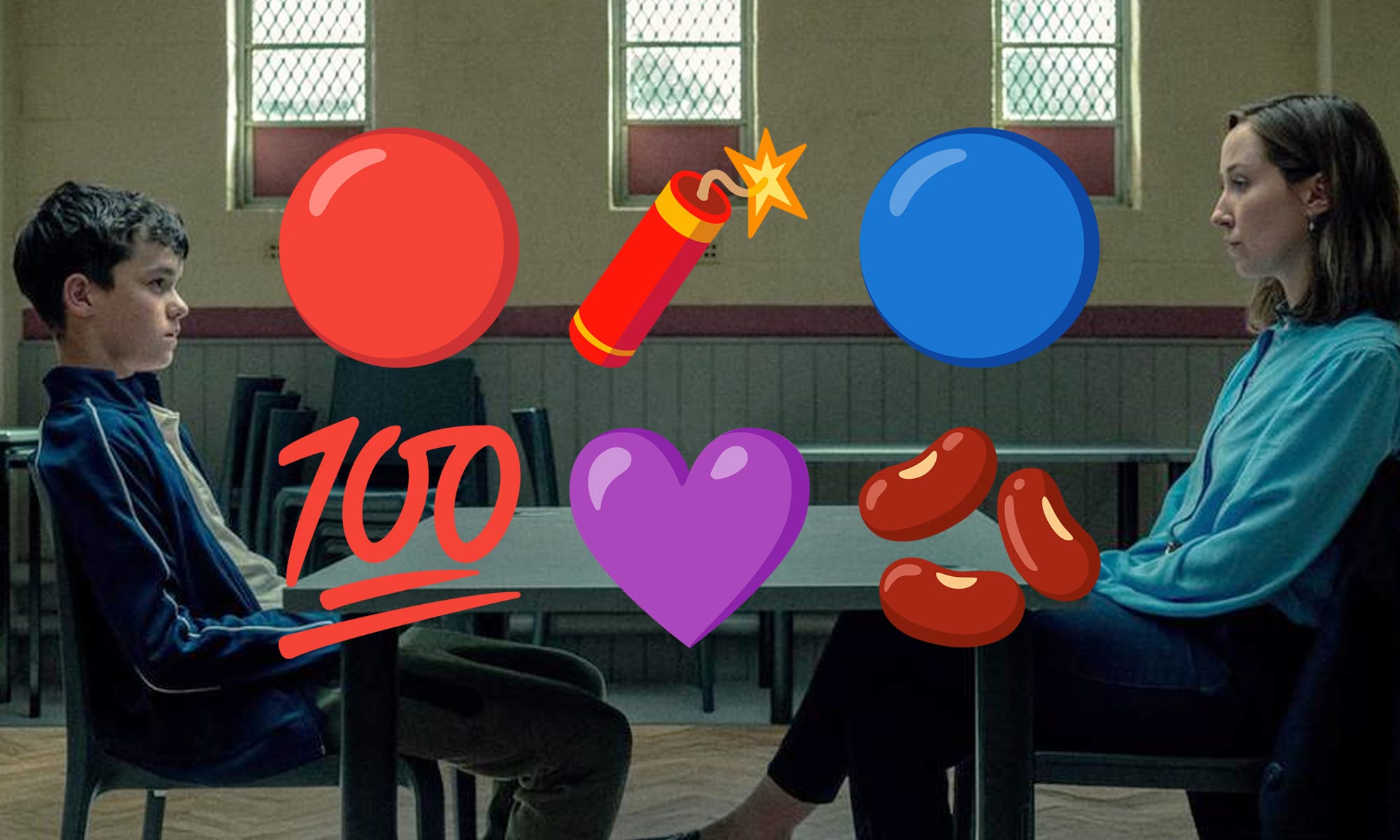Netflix's "Adolescence", Emoji Codes & Emoji Repurposing
Netflix’s "Adolescence" has gained global attention, not just for its story but for scenes exploring supposed hidden meanings in emojis. We examine how the show presents emoji use, question recent media claims about “secret codes,” and highlight how emoji repurposing isn’t new.

Since its release just a few weeks ago, Netflix’s four-part drama Adolescence has attracted a massive global audience. One scene, centered on the supposed hidden meanings of certain emojis, has sparked widespread media attention. In this article, we unpack how the show presents emoji use and why many reports about certain “secret meanings” are possibly misleading.
📺 Netflix's "Adolescence"?
In case you haven't heard of it before now, Adolescence is a British crime drama television mini-series released on Netflix on March 13, 2025.
The program's four episodes focus on the aftermath of a schoolgirl’s murder and the arrest of 13-year-old Jamie Miller as the prime suspect. As Jamie is held in custody, investigations uncover a pattern of social media bullying, including being labelled an “incel” by classmates based on emoji-laden Instagram posts.
Through police interviews and psychological assessments, the series explores how social media, isolation, and exposure to controversial worldviews converge in a deeply vulnerable young mind while also portraying the strain placed on Jamie’s family as they face public scrutiny and grief.
Since its release, the show has received widespread critical acclaim and quickly became the most-watched streaming series in the UK during a single week.
🕵️ The Emojis In Question
Mild spoilers for the show from this point onward.
Emojis are cited directly in two prominent moments in the show, with the first of these two instances occurring about halfway through the second episode.
In this scene, the son of Detective Inspector Luke Bascombe (who is involved in the case) explains to him that Instagram posts that Bascombe had assumed were childish flirtations are accusations casting Jamie as an incel.
Here are the emojis cited in this scene and what Bascombe's son Adam claims they mean. Note that we do not see any emoji designs on screen throughout the show, meaning it is at times uncertain which exact emoji is being referenced.
- "The Dynamite": most likely the 🧨 Firecracker, though also possibly the 💥 Collision based on an additional description in a later episode. Adam claims this is an "exploding red pill" (see below).
- "The Blue Pill": most likely the 🔵 Blue Circle, the blue pill is a reference to the film The Matrix where taking a blue pill would allow someone to remain in comfortable ignorance, continuing to believe a pleasant but false reality.
- "The Red Pill": most likely the 🔴 Red Circle, though it's possible it may be the 💊 Pill emoji. As with the blue pill, this is a reference to The Matrix, with the red pill letting the consumer "see the truth." In this specific interpretation, this is about a supposed awakening to harsh or controversial "truths" about society, gender roles, and male identity—often tied to misogynistic or anti-feminist ideologies.
- "The 100": the 💯 Hundred Points, which Adam claims is a reference to an interpretation of the "80/20" rule (the Pareto principle). In this specific interpretation, it's the belief that 20% of men receive 80% of female attention.
When Bascombe expresses skepticism ("It's a bit of a stretch"), Adam describes certain coded meanings his teenage peers use each of the color heart emojis for:
- ❤️ Red Heart: "Love."
- 💜 Purple Heart: "Horny."
- 💛 Yellow Heart: "I'm interested. Are you interested?"
- 🩷 Pink Heart: "I'm interested, but not in sex."
- 🧡 Orange Heart: "You're gonna be fine."
Adam then states, "I could show you 15 others. Messages sent to Jamie all. All different emojis. They're saying the same thing".
It's not clear if Adam means 15 unique different emojis or some other number of different emojis across 15 other Instagram posts.
However, one additional emoji is directly cited later in the third episode of the show: the 🫘 Beans emoji, described as "the kidney beans."
The emoji is mentioned by forensic psychologist Briony Ariston while conducting her final assessment of Jamie at a youth detention facility. Ariston produces printouts of Instagram posts and asks Jamie directly, "What do these emoji mean?"
Jamie responds, "She's pretending like I'm part of one of those truth groups."
He then begins to interpret another emoji that isn't named as meaning "want love, won't get it", before affirming the meaning of three other emojis in the Instagram posts that Adam described in the previous episode and that we've outlined above:
- "The Red Pill": 🔴 Red Circle or 💊 Pill.
- "Exploding—that's the same as the red pill": 🧨 Firecracker or 💥 Collision.
- "That's an 80/20 thing": the 💯 Hundred Points.
🍑 Emoji "Codes" and Emoji Repurposing
Rather than examining how these meanings emerge or how often they’re actually used in these alternative ways, many media reports take the show’s depiction at face value and have made claims that these described meanings in the show are broadly applicable. In doing so, they risk amplifying a moral panic that overlooks the broader, more nuanced picture of emoji usage online.
Indeed, despite the intrigue around Adolescence’s depiction of hidden emoji meanings, emoji repurposing is neither new nor inherently ominous.
Some of the earliest well-known emoji reinterpretations date back over a decade, with the 🍆 Eggplant and 🍑 Peach becoming widely used innuendos due to their visual resemblance to body parts.
These interpretations grew from niche jokes into mainstream symbols, appearing in pop songs, advertising, and even moderation guidelines on social platforms.
Other prominent examples show how different groups reimagine emojis to suit their cultural expressions. The 💀 Skull emoji has been adopted by Gen Z to mean “I’m dead” (i.e., something is hilarious), while 🧢 Billed Cap now symbolizes “lying” (from the slang “no cap”).
In the same way that these examples have been born out of slang, there is a whole host of different emoji interpretations that reference preexisting "not safe for work" slang, in particular in regards to sexual innuendo or illicit substances.
Fandoms have their own emoji lexicons, too. BTS fans use the 💜 Purple Heart emoji (cited in the show as meaning "horny") to signal “I purple you”—a phrase coined by member V to represent love and loyalty. Beyoncé fans use the 🐝 Honeybee emoji to show their allegiance to the "BeyHive," and Taylor Swift fans reference the 🧣 Scarf emoji in connection with "All Too Well (10 Minute Version)" and its symbolic red scarf.
These repurposings are emotional, cultural, and community-driven, often forming a kind of visual shorthand for shared experiences or identities.
These kinds of emoji uses often start as in-jokes or group references and scale through repeated exposure on platforms like X (fka Twitter), Instagram, and TikTok. This process can make certain meanings feel widely known, even if they originated in small corners of the internet.
However, this scaling can also lead to confusion. When media outlets or concerned parents encounter emojis being used in unfamiliar ways, they may assume there's a coded message or even a form of organized communication. In reality, most repurposed emoji meanings are context-specific: just because a group uses a particular emoji in a specific way doesn’t mean that meaning becomes the primary or universal one.
This is particularly true in the case of Adolescence, where emojis are linked to incel or "manosphere" culture within the show.
While certain online communities may assign ideological meanings to emojis like 🔴 Red Circle or 🧨 Firecracker, these interpretations are highly localized and not reflective of mainstream usage. The show dramatizes these meanings as hidden codes, but in reality, they are better understood as subcultural quirks—similar to slang or inside jokes that only carry weight within their originating spaces.
That said, by depicting how teenagers have come to understand these emojis in those specific ways, the show dramatizes how teenagers can encounter incel or manosphere concepts through online spaces.
💜 What About the Colored Heart Emojis?
One recurring theme in online conversations—and echoed in coverage of Adolescence—is the idea that every colored heart emoji carries a specific, hidden meaning.
But much like emoji “codes” more broadly, these meanings have more in common with digital chain mail than with linguistic truth. While some interpretations may be adopted temporarily by certain communities, they’re not fixed. People use colored hearts for all kinds of reasons: to match a color scheme, to support a cause (like 💚 Green Heart for environmentalism), or simply because it feels right in the moment.
Broadly speaking, all heart emojis convey affection, appreciation, or emotional connection. Their color might add tone or emphasis, but it rarely encodes a secret message. The idea that there’s one universal “correct” interpretation for each color is simply not true, even if certain colors may get used in specific contexts more frequently than others.
👪 What Can Be Done By Parents?
Understandably, scenes in Adolescence have sparked concern from parents and educators. But the core takeaway shouldn't be that emojis themselves are dangerous or inherently deceptive.
Young people have always reimagined language and symbols as part of their self-expression and emoji repurposing is just one part of that broader cultural evolution. While it’s impossible (and unproductive) to prevent teens from using emojis creatively, ironically, or playfully, it’s also important to remember that not every emoji carries a hidden or harmful meaning. In fact, most emojis are still used in their intended way—or, when repurposed, their meanings are harmless and far removed from any “manosphere” connotation.
Emojis aren’t encrypted messages—they’re flexible cultural tools. Like slang or memes, their meanings shift depending on context, community, and platform. Rather than treating them as fixed codes to crack, it’s more useful to view them as collaborative symbols shaped by humor, identity, and online communities.
If a message from your child includes emojis that seem out of place or feel inconsistent with the tone of the conversation, the best approach is simple: ask. A genuine, non-judgmental question like “Hey, I noticed you used this... what does that mean to you?” opens the door for meaningful dialogue. Teens are often happy to explain the jokes, references, or trends they’re engaging with, especially when approached with curiosity rather than suspicion.
Ultimately, Adolescence may frame the issue as one of emoji “codes,” but the more important conversation is about the wider digital environments young people are navigating. Open communication about internet use, digital culture, and online behavior will always be more effective than trying to stay ahead of an ever-shifting symbolic paralanguage. Rather than focusing on individual emojis, it’s more valuable to understand which platforms your child is using, the kinds of content they’re seeing, and the values of the communities they’re part of.
